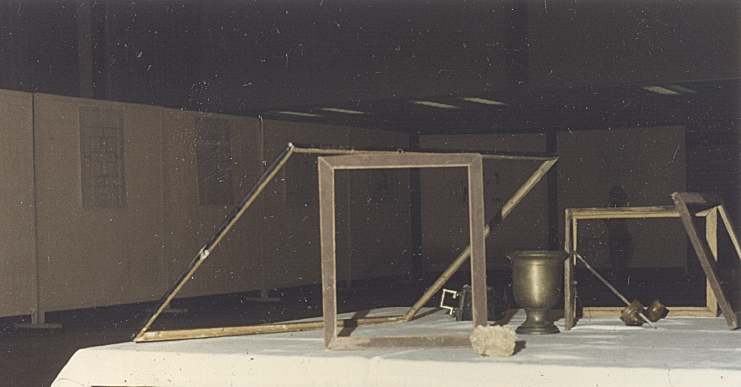Natyrë e vdekur e vitit 1984, Dead nature of the year 1984 / Instalation, 1984, FILOART, Exhibition View, 1986, Pallati i Rinisë, Prishtinë
In some languages the term “dead nature” is used for still life. At first sight it looks like a normal arrangement (setting), of a classical still life.
Several objects are spread over a drapery fabric, usually seen in most still life paintings: A silver teapot, a bronze mortar, a mineral stone, a violin neck, a painting brush.
All the objects in the still life setting are authentic, from the Baroque period.
These objects could be found in the studio of most painters at the beginning of the 17th century, but they can also be seen as drawing or painting motifs at some art academies even today.
Behind the Frames
But then another layer appears at this installation: frames. Frames without paintings. “Empty” frames placed around the still life setting, in different positions. They are simultaneously “inside” and also, “outside” of the installation. The objects of the still life lies behind, next to, or in front of the frames.
When the frame shows up, the “still life” is in another context, suddenly space starts to change the meaning and it loses its original structure!
You can see the “front” and the “back” of the work. You can see at the same time a “front” side of one frame and also the “back” sides of other frames. You can see what is in the frame and what is out of it, but also the whole installation as one. What looks fa- miliar in one moment becomes unknown in the next. The whole space becomes totally unpredictable.
Layers over Layers
In this installation the frames build a kind of border between the observer and the still life.
Even if the frames are placed around the setting, they are in fact part of the installation and build the construction of the work. The most confusing and irritating effect of the frames is that they visually absorb everything around them. Everything that is behind them: the still life setting, the observers, simply the entire space, becomes a part of work. Who / what is inside the frame and who / what is outside the frame? Are we observing the work from within or from without?
When we start to realize all these layers, the whole situation becomes unstable and difficult to understand or explain.
Who is observing whom?
What is the observer actually looking at when he looks at this work: a couple of centuries old scene, or a contemporary work, or both?
Is this work a kind of compressed time?
What kind of relation has this scene with the present?
When we observe in the present a still life painting from the Ba- roque, we don’t see the still life but what the painter saw. This type of painting is also a kind of compressed picture (frame) of many, which the painter in time built (reduced) to only one. That means we are observing somebody else observing, we are seeing him spending his time observing.
In the work Dead Nature of the Year 1984 there is nobody (no painter) standing between the observer and the work. The moment we think that the observer here is only the observer, we get in a pitfall.
If there is at least one more person in the exhibition area, the observer is no longer only the observer – he becomes another layer, he is now also observed and a part of this installation.
Dead (nature) or (still) life
This installation through a minor intervention with the frames, suddenly changes the genesis of the name “still life” or “dead nature” dramatically. During the presentation, with the presence of visitors, the installation is always filled with movement and sightings. So, we can no longer claim that this work is dead (nature) or still (life). In fact, it is the opposite – this installation is in motion and under visually permanent changing.
25 frames
If these frames give a completely different dimension and meaning to this installation, what about the frames (pictures) that our brain collects uninterruptedly?
What does it mean to see and how does it function?
How do our brains recall them (frames/pictures)? Where does the picture arise? Who is who?
The fact that this work is placed* in the middle of the presen- tation room, then raises the question: is this work part of the presentation or is the presentation which surrounds this work
a part of the work, since through the frames you can see the whole presentation. This question brings the whole situation ad absurdum or to the zero point or into the Möbius strip.
This installation relates very much to the title of the presenta- tion from 1987, where the exhibit This is not the exhibition but the opposite took place.
____________________
*Wherever this work is exhibited, it’s a different work. Where does the frame start and where does it end? Does it start/end in the frame or in our heads? Where does this work start and where does it end?
Can we even talk in terms of the beginning or the end of the work? Or is this the end of the work and the beginning of some- thing else?!
This work is maybe an anti-work.
It destroys the self-evidence of one work only with one addi- tion to the work. It questions the certainty of the period, the certainty of the style.
